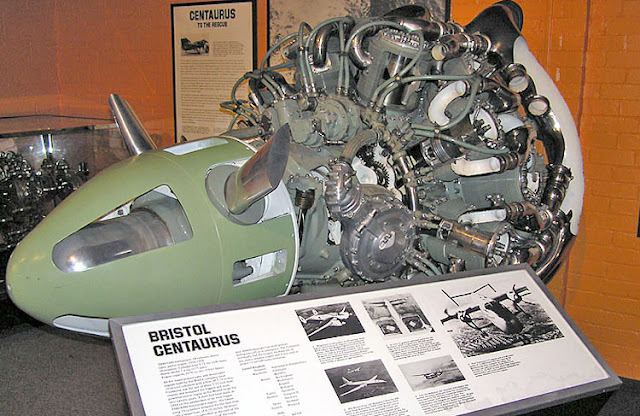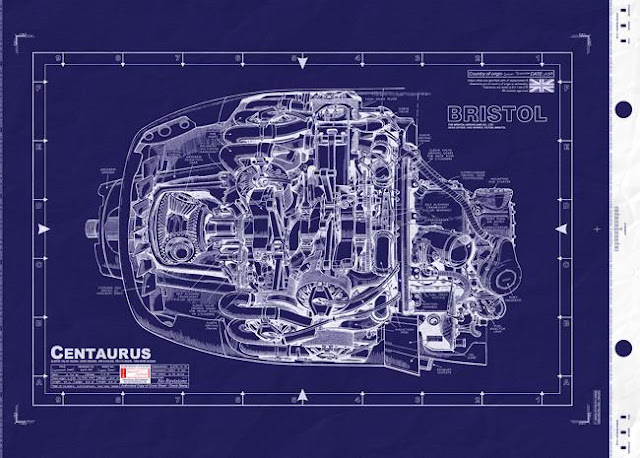Il Bristol Centaurus era un motore radiale 18 cilindri doppia stella raffreddato ad aria sviluppato dall'azienda britannica Bristol Engine Company nei tardi anni trenta.
Utilizzato da numerosi modelli di velivoli militari e civili, fu uno degli ultimi motori a pistoni ad equipaggiare aerei di linea prima della diffusione, anche nell'aviazione civile, dei motori a getto.
Storia
Sviluppo
Il Centaurus rappresenta l'ultimo sviluppo nei motori a pistoni dotati di valvole a fodero prodotti dalla Bristol Engine Company, divisione motoristica della Bristol Aeroplane Company. Il Centaurus era un grande Motore radiale a 18 cilindri disposti su due stelle di 9 cilindri ognuna. Nelle ultime versioni il motore erogava 3 000 hp (2 237 kW).
Come molti motori prodotti dalla Bristol, della quale riprendeva la meccanica generale, anche il Centaurus era dotato del classico, per la Bristol, pistone da 146 mm di diametro che era stato usato per la prima volta nel 1918 sullo Jupiter. In questo motore il pistone era sistemato in un cilindro a corsa lunga. Questo, e il raddoppio del numero dei cilindri, faceva sì che la cilindrata totale del motore raggiungesse i 53,6 litri, facendolo entrare di diritto tra i più grandi motori a pistoni del suo tempo.
La Bristol considerava il motore pronto per il 1938 ma la produzione non cominciò che nel 1942. In realtà alla fine il motore verrà utilizzato solo verso la fine del secondo conflitto mondiale. Il suo primo impiego si ebbe su un velivolo non molto fortunato: il Vickers Warwick. Fu poi impiegato, anche dopo la fine del conflitto, sul Bristol Brigand e sul Buckmaster, sullo Hawker Tempest II e Sea Fury. Venne utilizzato anche sul Blackburn Firebrand. Il motore conobbe anche un limitato impiego civile. Erano dei Centaurus i motori utilizzati sul Brabazon, progetto fallito per un grande velivolo da trasporto commerciale postbellico di produzione britannica.
Sebbene per alcuni punti di vista fosse, alla fine del conflitto, ritenuto più affidabile degli equivalenti motori stellari di grande potenza americani il Centaurus non ebbe, a causa della diversa forza dell'industria aeronautica inglese, la stessa diffusione di questi ultimi. Inoltre con l'avvento del de Havilland DH.106 Comet, primo aviogetto di linea al mondo, il suo destino quale motore per l'aviazione commerciale era in ogni caso ormai segnato.
Velivoli utilizzatori
Italia
- Breda BZ 308
Regno Unito
- Airspeed Ambassador
- Blackburn Beverley
- Blackburn Firebrand
- Blackburn Firecrest
- Bristol Brabazon
- Bristol Brigand
- Bristol Buckingham
- Bristol Buckmaster
- Fairey Spearfish
- Hawker Sea Fury
- Hawker Tempest
- Hawker Tornado
- Short Solent
- Vickers Warwick.
ENGLISH
The Centaurus was the final development of the Bristol Engine Company's series of sleeve valve radial aircraft engines. The Centaurus is an 18-cylinder, two-row design that eventually delivered over 3,000 hp (2,200 kW). The engine was introduced into service late in the Second World War and was one of the most powerful aircraft piston engines to see service. The Royal Navy Historic Flight operates a Hawker Sea Fury, powered by a Bristol Centaurus engine.
Design and development
Like most Bristol Engines designs, the Centaurus was based on the mechanicals of an earlier design, in this case the "classic" 5.75 in (146 mm) piston from their original 1918 Jupiter. The Jupiter piston was in use in the contemporary 14-cylinder Hercules, which was being brought into production when the design of the Centaurus started.
The Centaurus had a cylinder swept volume of 3,272 in³ (53.6 l), nearly as much as the American 54.9-litre Wright R-3350 Duplex-Cyclone large radial, making the Centaurus one of the largest aircraft piston engines to enter production, while that of the Hercules was 2,363 cubic inches (38.7 l). The nearly 40 percent higher capacity was achieved by increasing the stroke from 6.5 to 7 in (170 to 180 mm) and by changing to two rows of nine cylinders instead of two rows of seven. The diameter of the Centaurus was only just over 6 percent greater than the Hercules in spite of its much greater swept volume.
The cylinder heads had an indentation like an inverted top hat, which was finned, but it was difficult to get air down into this hollow to adequately cool the head. During development, the engineers contacted ICI Metals Division, Birmingham, to enquire whether a copper-chromium alloy with higher thermal conductivity would have sufficient high temperature strength to be used for this purpose. Tests were successful and with the same volume of cylinder, these modified heads enabled the horsepower per cylinder to be raised from 110 hp to 220 hp.
Bristol maintained the Centaurus from type-testing in 1938, but production did not start until 1942, owing to the need to get the Hercules into production and improve the reliability of the entire engine line. Nor was there any real need for the larger engine at this early point in the war, when most military aircraft designs were intended to mount engines around 1,000 hp. The Hercules's approximately 1,500 hp was better suited to the existing airframes.
The Centaurus did not see service until near the end of the war, first appearing on the Vickers Warwick. Other wartime, or postwar, uses included the Bristol Brigand and Buckmaster, Hawker Tempest and Sea Fury and the Blackburn Firebrand and Beverley. The engine also saw post-war use in civilian airliners, including the ill-fated Bristol Brabazon. By the end of the war in Europe, around 2,500 examples of the Centaurus had been produced by Bristol.
The 373 was the most powerful version of the Centaurus and was intended for the Blackburn Beverley transport aircraft. Using direct fuel injection, it achieved a remarkable 3,220 hp, but was never fitted. A projected enlarged capacity version of the Centaurus was designed by Sir Roy Fedden; cylinders were produced for this engine, but it was never built. Known as the Bristol Orion, a name used previously for a variant of the Jupiter engine and later re-used for a turboprop, this development was also a two-row, 18 cylinder sleeve valve engine, with the displacement increased to 4,142 cubic inches (67.9 l) (6.25 × 7.5), nearly as large as the American Pratt & Whitney R-4360 Wasp Major four-row, 28-cylinder radial, the largest displacement aviation radial engine ever placed in quantity production.
Variants
The Centaurus was produced in 34 variants, ranging from the 2,000 hp (1,490 kW) Centaurus I to the 2,405 hp (1,793 kW) Centaurus 663 for the Airspeed Ambassador airliner. The most powerful variants to enter service were the 2,625 hp (1,957 kW) Centaurus 170, 173, 660, 661 and 662.
Applications:
- Airspeed Ambassador
- Blackburn Beverley
- Blackburn Firebrand
- Blackburn Firecrest
- Breda BZ.308
- Bristol Brabazon
- Bristol Brigand
- Bristol Buckingham
- Bristol Buckmaster
- Fairey Spearfish
- Folland Fo.108 (the Fo.108 was a testbed aircraft for various engines)
- Hawker Fury
- Hawker Sea Fury
- Hawker Tempest
- Hawker Tornado
- Short Shetland
- Short Solent
- Vickers Warwick.
Survivors
The Royal Navy Historic Flight operates a Hawker Sea Fury powered by a Bristol Centaurus.
Engines on display
Preserved Bristol Centaurus engines are on public display at the following museums:
- Aerospace Museum of California
- Fleet Air Arm Museum
- Imperial War Museum Duxford
- London Science Museum
- Midland Air Museum
- Shuttleworth Collection, Old Warden
- Dumfries and Galloway Aviation Museum
- San Diego Air & Space Museum.
Specifications (Centaurus VII)
General characteristics:
- Type: 18-cylinder, air-cooled, two-row radial engine
- Bore: 5.75 in (146 mm)
- Stroke: 7 in (177 mm)
- Displacement: 3,270 in³ (53.6 l)
- Diameter: 55.3 in (1,405 mm)
- Dry weight: 2,695 lb (1,223 kg)
Components:
- Valvetrain: Sleeve valve, four ports per sleeve
- Supercharger: Two-speed centrifugal, single stage
- Fuel system: Injection
- Fuel type: 100/130 Octane petrol
- Oil system: Direct-pressure lubrication
- Cooling system: Air-cooled
Performance:
- Power output: 2,520 hp (1,880 kW) at 2,700 rpm
- Specific power: 0.77 hp/in³ (35.1 kW/l)
- Compression ratio: 7.2:1
- Power-to-weight ratio: 0.94 hp/lb (1.54 kW/kg).
(Web, Google, Wikipedia, You Tube)
































Nessun commento:
Posta un commento
Nota. Solo i membri di questo blog possono postare un commento.